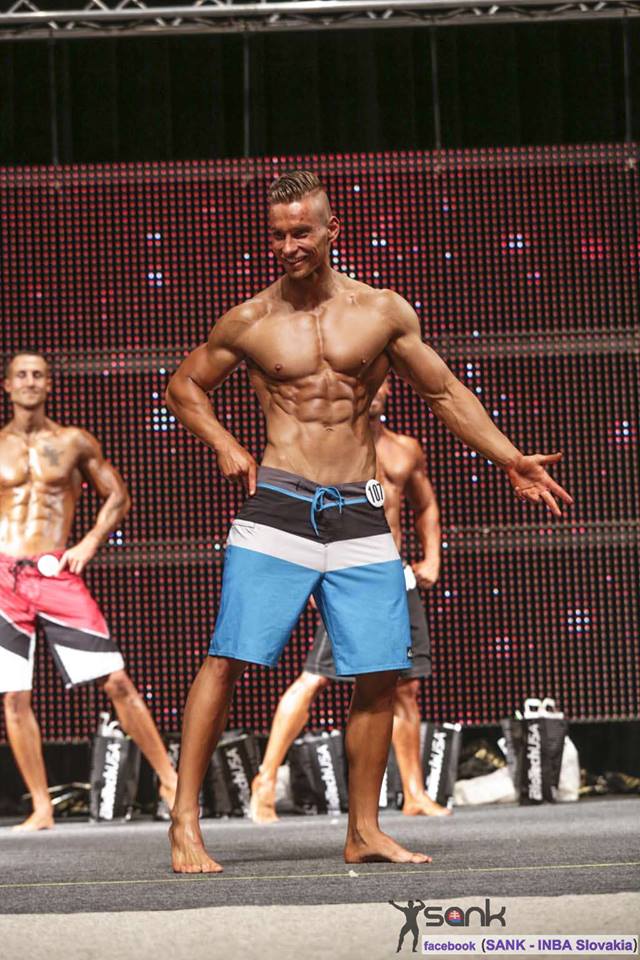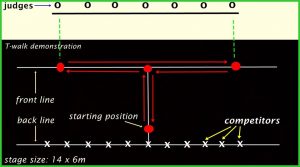
MEN'S PHYSIQUE
Definition of judges criteria
Basic rules of judges criteria of a natural bodybuilding for the category Men’s Physique
-rules define individual parts of bodybuilding competitions (elimination, pre-judging, finals)
-how the individual parts of bodybuilding competitions are judged
Competition clothing and preparation of athletes
An athlete shows swimwear for approval at the registration. Athletes must wear
loose shorts of the colour of thier choice, mid-knee length. Any close-fitting or elastic shorts are not allowed. A logo of a sports club is allowed, a trade mark logo is not allowed. Shorts must not be decorated. Any jewellery or accessories are prohibited.
It is not allowed to wear shoes on stage, watches, bracelets, earrings or metal objects. Competitors, during their presentation on the stage, must not have chewing gum or anything else in their mouth, must not use any props.
Elimination
In case of a higher number of athletes – more than 12 in the category- an elimination is carried out.
The secretary of the head judge gives out The Elimination form to all judges. There are already written down registration numbers of athletes in each category.
A supervisor (or a stage judge) lines the athletes on the stage according to their registration number beginning with the lowest number from the left side of the stage in a row (if necessary, in two rows). Athletes stand in the basic stance. Then they do quarter turns based on the head judge´s instructions. Consequently,they are instructed to change the stance by exchanging the numbered positions – starting with the lowest registration number from the right to the left and are asked to repeat quarter turns.
After finishing quarter turns, athletes approach the judges according to their registration numbers, no more than five of them, to perform 3 mandatory poses.
-front double biceps
-back double biceps
-abdominals
Semifinals (Pre – judging)
1st round – Pre – judging
-judging the physique in quarter turns
-judging the muscularity (mandatory poses)
Description of particular parts of the competition
1.round – Pre – judging
Judging the physique ( quarter turns, mandatory poses)
A supervisor (or a stage judge) guides the athletes to the stage according to their registration number beginning with the lowest number from the left side of the stage. A moderator or a stage judge introduces all athletes by a registration number and a name. At the command of the moderator or the stage judge, all athletes perform four quarter turns – always one quarter turn to the right.
Judging of the first round the follows several criteria:
Category Mr. Physique is designed for men and juniors who prefer a less muscular, yet athletic and aesthetically pleasing physique. We judge an athletic figure, proportionality, muscularity and mutual harmony of individual muscle groups- with an emphasis on width of a chest, shoulder development and depth of abdominal muscles. This is not a bodybuilding category, so athletes with great muscularity or too skinny ones,will be judged by a lower mark. The overall impression and presentation of the athlete must be pleasant, radiating energy, strength and joy of a competition. The judgement will take into account the state of epidermis, colour, clothing and a proper performance of individual stances.
Demonstration of individual muscle should not be crampy what is frequently performed by some athletes.The athlete’s face should present confidence, showmanship and their pleasure of taking part in the competition. When judging the physique, tightness and tonus of epidermis should also be considered – skin is supposed to be smooth and healthy looking.
Judgement includes an athlete’s performance since their arrival on stage to the moment when they are leaving.
Pre-judging consists of two parts (quarter turns and physique judgement):
Quarter turns:
Athletes arrive at the stage without wearing T-shirts and barefoot. Any impolite performance is forbidden, such as posing with exposed bottom. Athletes stand in a line, according to registration numbers facing judges and perform -four quarter turns to the command of the head judge – “Quarter turn to the right”.
This comparison is performed as follows:
Facing front:
Athletes stand with one hand on their hip and one leg is slightly forward and to the side.
Quarter turn to the right:
Athletes make a quarter turn to the right with their left side turned to judges. Upper body is slightly turned towards judges,looking at judges. The left hand is on a hip, the right arm is slightly bent along the central line of the body, the hand is open (not clenched in a fist!). The positioning of the hands causes gentle rotation of the upper body to the left, with the left shoulder lowered and the right stretched forth above. The right leg is slightly bent and backwards.
Quarter turn with the back to the judges:
Athletes make a quarter turn to the right standing with their back to the judges. One hand is on the hip, the other hand is slightly bent beside the body. Athletes must not turn their upper body towards the judges.
Quarter turn to the right:
Athletes make a quarter turn to the right with their right side turned to judges. Upper body is slightly turned towards judges, looking at judges. The right hand is on a hip, the left arm is slightly bent along the central line of the body, the hand is open (not clenched in a fist!). The positioning of the hands causes gentle rotation of the upper body to the right, with the right shoulder lowered and the left stretched forth above. The left leg is slightly bent and backwards.
Quarter turn to the right, facing front:
Athletes make a quarter turn to the right, facing judges – they stand in a front pose.
Judging the physique in the following five mandatory poses:
- FRONT DOUBLE BICEPS (hands and fingers open- not in a fist)
- SIDE CHEST (hands and fingers open- not in a fist)
- SIDE TRICEPS (hands and fingers open- not in a fist)
- BACK DOUBLE BICEPS (hands and fingers open- not in a fist)
- ABDOMINALS – abdominals with hands behind head
Judges compare and evaluate at least two and no more than five athletes at a time. The head judge, on his own, can decide to reject or correct the individual requirements of judges for comparison. All individual comparisons will be placed in the center of the stage and in the order from the left to the right as required by judges. Each judge is eligible to submit at least one request for comparisons.
Finals
2nd round– Finals

Men’s Physique T-walk
1. An athlete goes to starting position and makes the “greeting” pose.
2. An athlete goes to the front line middle position makes a pose of mandatory poses.
3. An athlete goes to the left side of the stage and makes a pose of mandatory poses.
4. An athlete goes to the right side of the stage and makes a pose of mandatory poses.
5. An athlete goes to the middle position makes a pose of mandatory poses.
6. An athlete goes to starting position and makes the “goodbye” pose.
7. An athlete goes to back to the back line.
* No pose should be repeated in the T-walk.
Men’s Physique I-walk
1. An athlete goes to starting position and makes the “greeting” pose.
2. An athlete goes to the front line middle position makes 4 poses of mandatory poses.
3. An athlete goes to starting position and makes the “goodbye” pose.
4. An athlete goes to back to the back line.
* No pose should be repeated in the I-walk.
After T-walk, athletes come to the middle of the stage in a row in the order from the lowest registration number. Subsequently, the whole row performs four quarter turns. The head judge (or a stage judge) changes the position of athletes from the highest to the lowest registration number and they perform mandatory poses again. We compare symmetry, proportionality and the shape of a physique.
After quarter turns, the finalists are asked to leave the stage.
Judgement shall be written down into the arbitration tables. The one lowest and one highest score is crossed out. Subsequent evaluation of the pre-judging and the finals multiplied by the coefficient are counted up. Athletes with lower sum of positions are in the final evaluation on a higher position. The winner is the one with the lowest sum of positions. When the sum of points is the same, the final ranking depends on the athlete‘s position in the pre-judging, respectively, in the finals.

